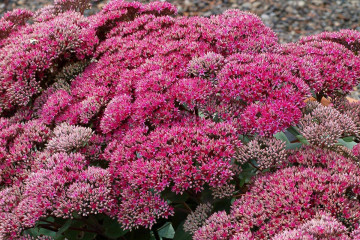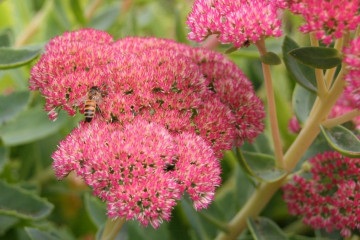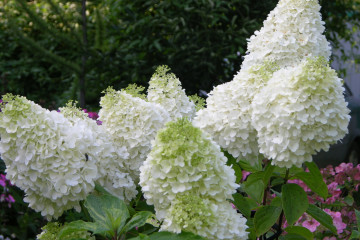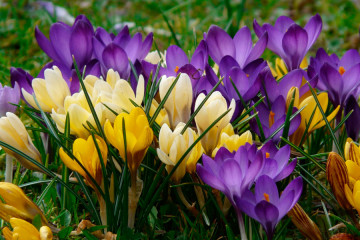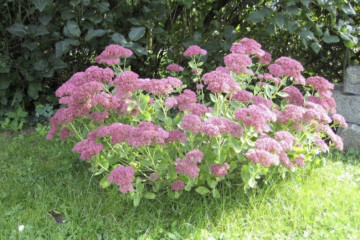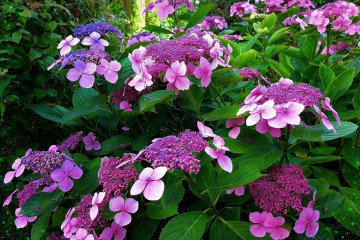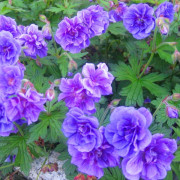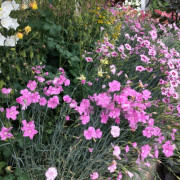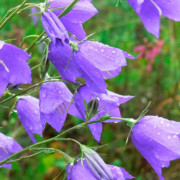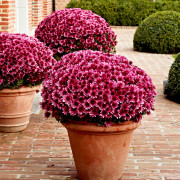Sedum varieties and types - the best varieties for the garden
Content:
- What does sedum look like
- Classification of creeping (ground cover) stonecrops, their popular varieties
- Classification of tall stonecrops and their characteristics
- Classification of unpretentious species
- Rare types of stonecrop
- Heat-loving species and their popular varieties
- How stonecrop multiplies
- Features of care in the garden
- Possible growing problems
- Use in landscape design
The species diversity of this plant will amaze even the most experienced flower growers. Sedum can be found in indoor breeding conditions and exquisite landscape compositions. It is called differently: in addition to the usual sedum or sedum, for the fleshy dense leaves it was also called hare cabbage, squeaky or rejuvenated.
What does sedum look like
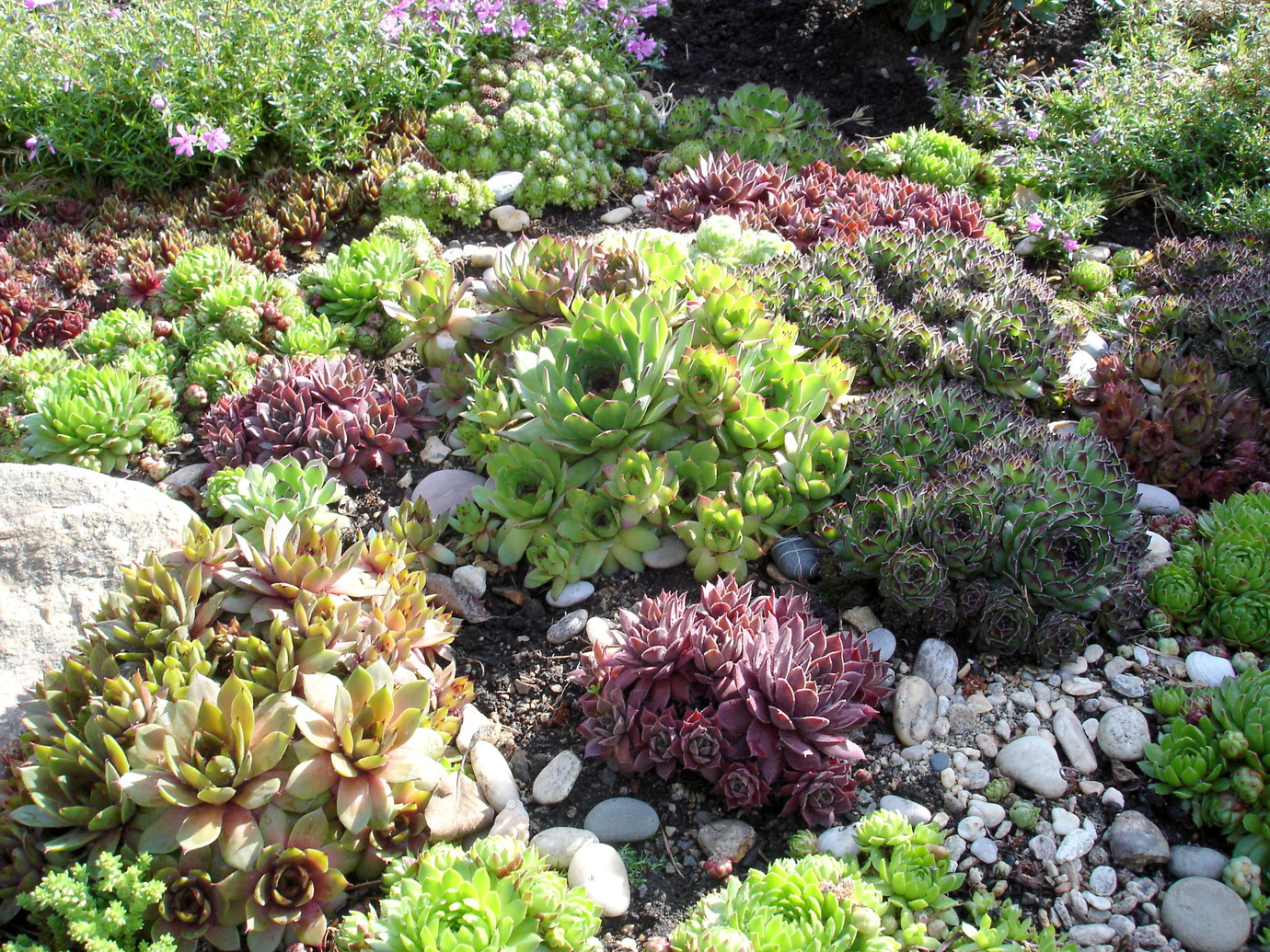
Sedum is widely used to create harmonious landscape compositions.
There are more than 600 species of sedum, strikingly different from each other in the shape of the leaves, their color, height and structure of the plant. Among other succulents, they can be recognized by a number of common features.
What family does it belong to
Rejuvenated - a bright representative of the Tolstyankov family. These can be miniature ground cover sediments, plants of medium height, as well as upright powerful herbaceous shrubs.
The unifying features of the species are:
- the ability to accumulate moisture in all parts of the plant, which leads to a thickened structure of leaves, stems and roots;
- lack of petioles, leaves are attached directly to the shoot;
- ability to withstand very hot climates and long periods of drought.
The history of the appearance and characteristics of the plant
The sedum plant, varieties and species that have been described thousands of years ago, was previously referred to as a succulent native to America and Africa. On the territory of the CIS, sedums were also widespread, they were grown many hundreds of years ago, so it is difficult to call it rare.
Stonecrops include stunted and tall herbaceous varieties of succulents. They can be perennial or biennial. They are divided into tropical forms, grown in indoor conditions, and winter-hardy species, suitable for use in landscape design.
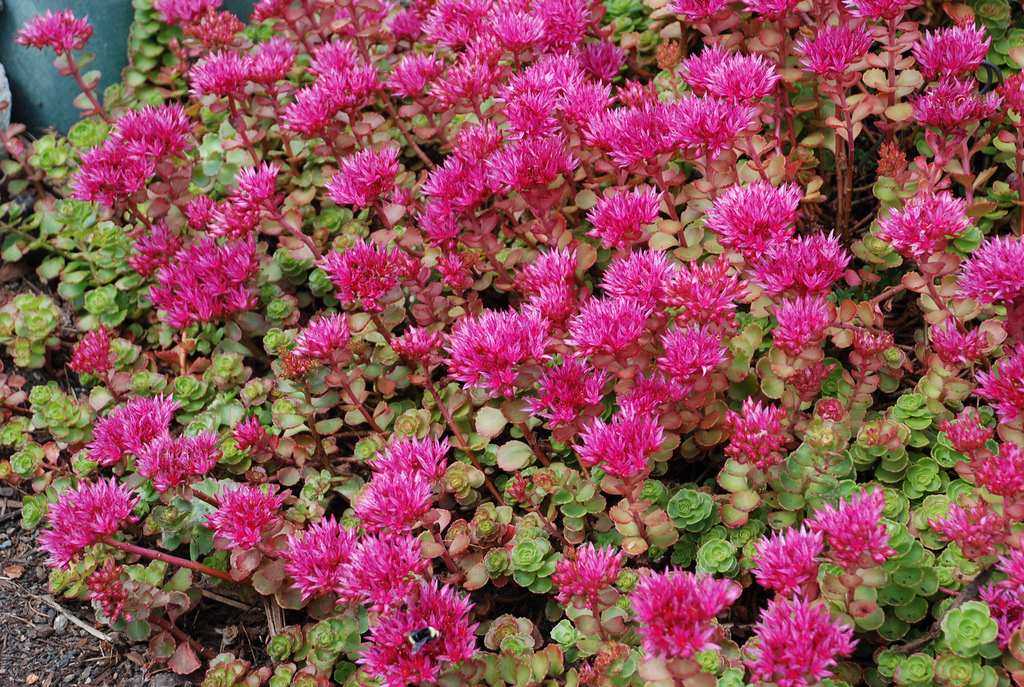
Sedum false sedum spurium has gained great popularity due to its exuberant flowering in the form of a dense "cap" that completely covers the foliage
A succulent plant has the following characteristics:
- The form. Ground cover creeping or bush erect plant. The height can range from 4-5 to 80 cm.
- Leaves. Petioleless, oppositely located, pressed to the stem. They are cylindrical or flat. Fleshy and firm to the touch, thickened, covered with a bluish bloom.
- Color. Most sedums are bluish-green in color, but there are also varieties with pink, red-burgundy leaves, turning into light spots. The color of the plant can vary depending on the lighting and the composition of the soil in the place of growth.
- Bloom. Sedum blooms in summer or autumn. They have dense umbellate inflorescences consisting of small star flowers. The inflorescences are colored white, yellow, pink, blue or red.They give off a pleasant aroma that attracts insects.
The benefits of the plant
The plant has unique medicinal properties, general tonic and strengthening effect. Some varieties of stonecrops are widely used in traditional medicine.
The most valuable are 3 types:
- The sedum is large or purple. It has anti-inflammatory, tonic, stimulating and wound healing effects. Antineoplastic drugs are made on its basis. It is also an effective biogenic stimulant that does not cause side effects. In medicine, it is used as an adjuvant for the treatment of kidney diseases, nervous disorders, diseases of the bladder and oncology.
- Sedum is prominent. Preparations prepared on the basis of succulent are used to treat anemia, epilepsy, chronic diseases of the gastrointestinal tract, lung diseases, etc. The plant is also used as a tonic that increases immunity.
- Acrid sedum. It has an analgesic and diuretic effect. Preparations based on it are used to treat non-healing wounds and burns, diseases such as dropsy, anemia, jaundice and skin tuberculosis.
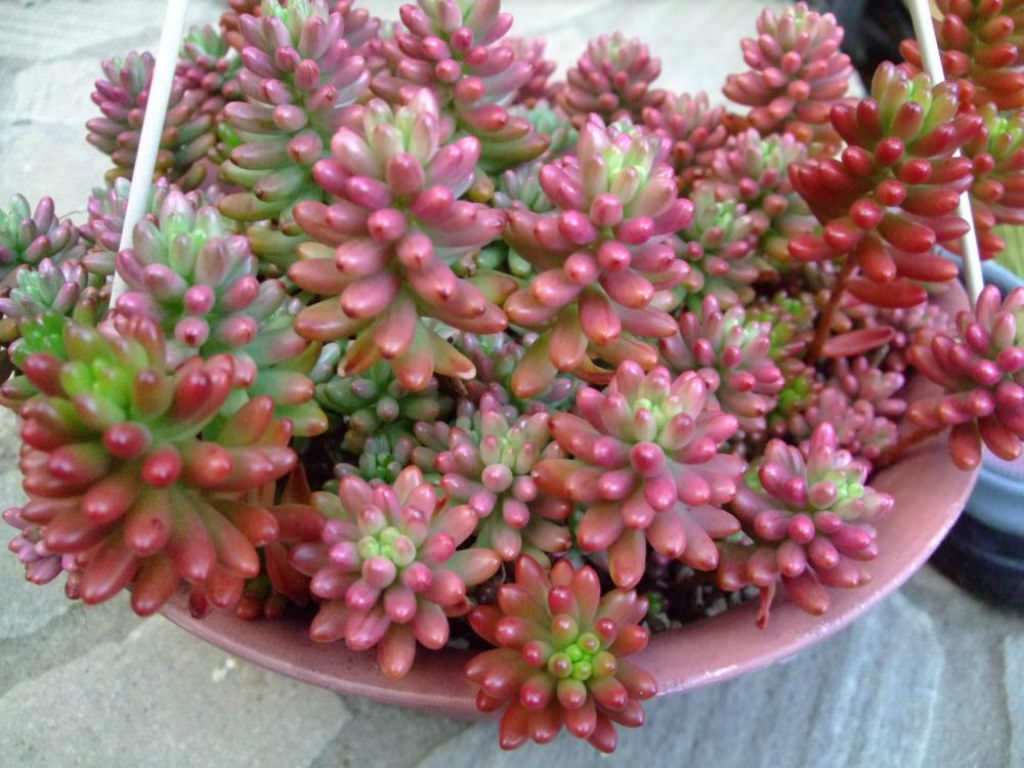
Sedum Big or Thick-leaved accelerates metabolic processes in tissues, promotes their regeneration
It also has a general tonic, immunostimulating effect on the body.
In folk medicine, the plant is also widely used:
- water tincture on the leaves of stonecrop helps well with intestinal disorders, kidney and heart diseases, it is used for vitamin deficiency and scurvy;
- fresh sedum juice is taken to treat inflammation of the organs of the female reproductive system, is effective for epilepsy;
- dried leaves and root of the plant are used for rheumatism and arthritis;
- fresh sedum leaves crushed into gruel are applied in the form of compresses to soften calluses;
- pickled leaves of the plant are taken for sexual impotence and female infertility.
Classification of creeping (ground cover) stonecrops, their popular varieties
This species includes lodging plants up to 30 cm high. Sedum Voodoo barely reaches a height of 6 cm. The spreading stems of stonecrop very quickly form a dense carpet, launching additional roots on creeping shoots. Most sedums of this group are evergreens that can withstand the harsh climatic conditions of the middle zone.
Plants are widely used, equipping them with frame topiary, landscaping sloping roof slopes. It is impossible to imagine the design of alpine slides and stone gardens without stonecrops.
Sedum anacampseros
The Pyrenees and the mountain slopes of the Alps are considered its homeland. It is a perennial plant that forms a dense carpet. In winter, the aboveground part of the stonecrop dies off. The sedum has horizontally spreading curved shoots, densely branched. Leaves are ovoid, with rounded edges, closer to the base of the plant, they change the shape of the leaf to wedge-shaped. The inflorescence consists of small flowers with a diameter of 5 to 7 cm, collected in umbrellas on small stalks. The color of the petals is pink with a purple tint. Stonecrop blooms in the middle of summer, flowering duration is no more than two months.
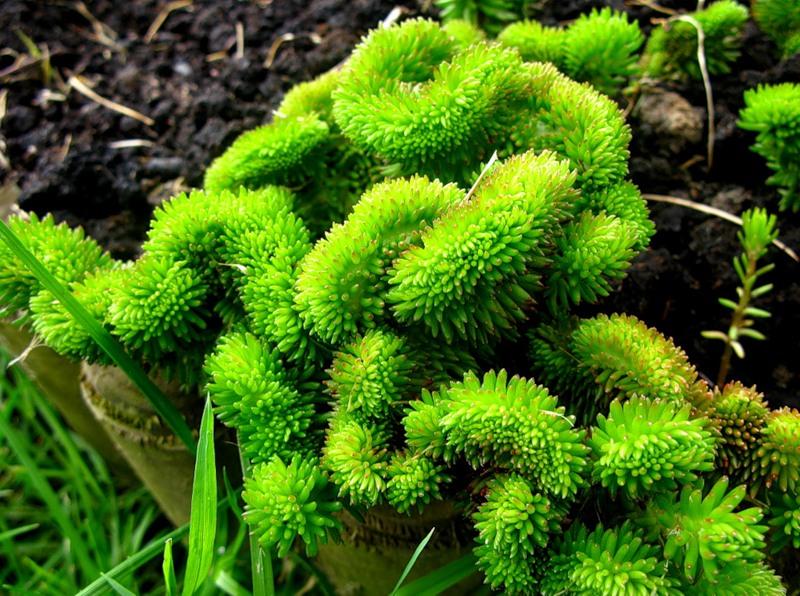
The sedum sedum has a very unusual and decorative appearance, it forms a plant that looks like thickets of sea corals
Stonecrop cornflower (Sedum cyaneum)
Forms a plant cover up to 10 cm high. Leaves are oval, bluish in color with red blotches. It blooms from August to September, very profusely, with dark pink flowers up to 0.5 cm in size. A frost-resistant species that prefers sunny places and well-drained soil.
Sedum hybrid (Sedum hybridum)
It is classified as an evergreen plant of the Zivuchnik family.The sedum grows in continuous canvases. Leaves are rich green. Flowering begins in late summer and lasts until September. The height of the peduncles can reach 25 cm, the petals are golden in color, collected in small star-shaped flowers. It tolerates severe winters and summer droughts. Bright representatives of the species are the Yellow Queen sedums and the Purple Emperor.
Sedum thick-leaved (Sedum dasyphyllum)
Perennial no more than 6 cm in height, has dense leafy shoots, closing in a continuous canvas. The leaves are green-blue ovoid, their length is no more than 1 cm. It has white flowers, flowering can be observed from August to September.
Sedum sieboldii
Winter-hardy form of succulent. It has well-rooted arcuate shoots covered with flat rounded leaves. The leaf is colored gray with a bright red toothed edging. There are varieties with a yellow stripe dividing the leaf in half. Long bloom, from April to June. The inflorescences are deep pink, thick and fragrant.
Kamchatka sedum (Sedum kamtschaticum, Sedum floriferum)
The plant forms a bush with a height of 15 to 25 cm. Shoots are semi-lying, creeping, covered with small cut toothed leaves. The color of the plant can vary from green to dark red depending on the light. Blooms from July to early October with golden-orange inflorescences. It has attractive numerous fruits of bright scarlet color.
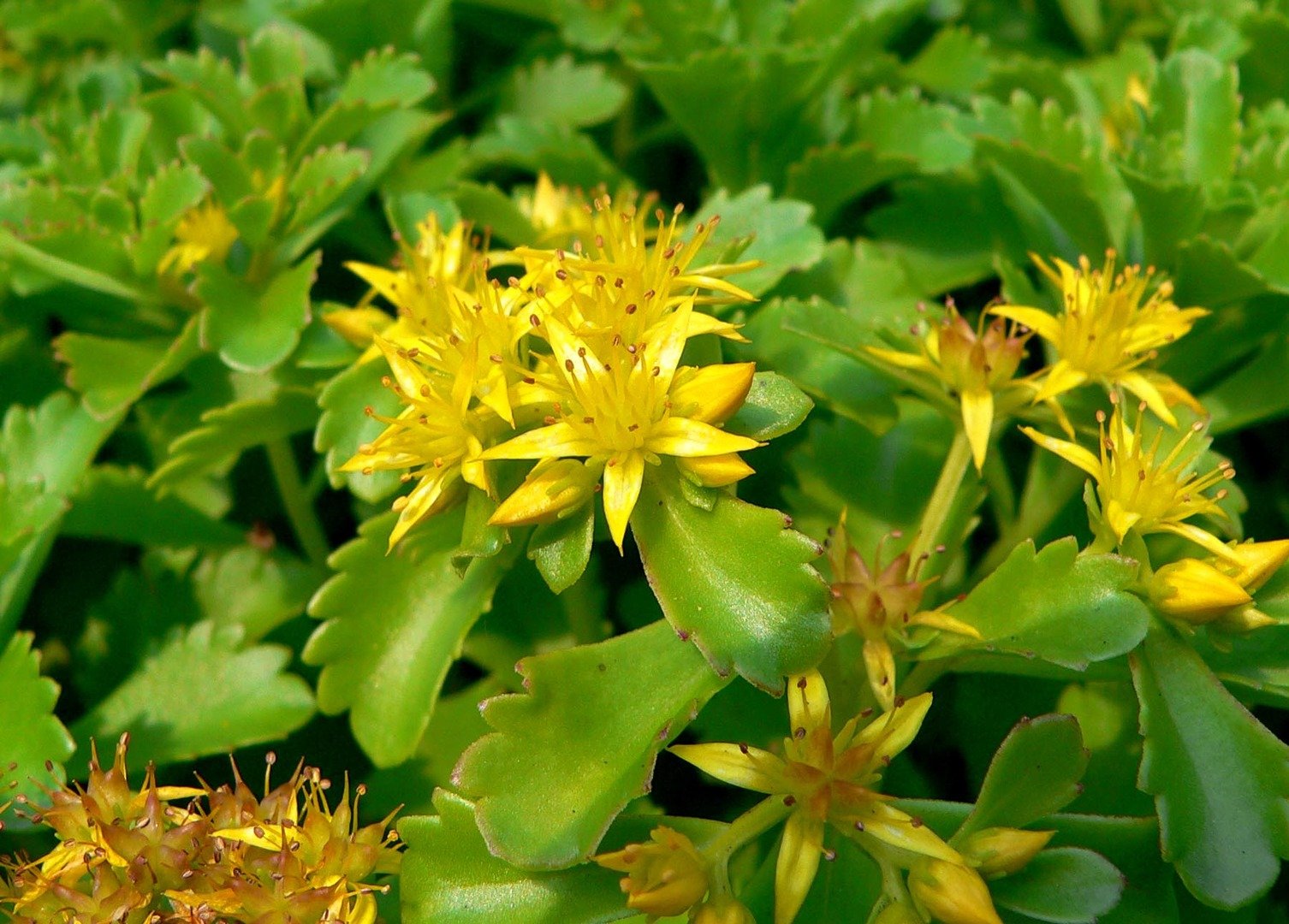
Sedum Kamchatsky develops well, both in sunny and shaded places, but does not tolerate drought
Kuril sedum (Sedum kurilense)
Refers to perennial frost-resistant succulents. Reaches a height of no more than 10 cm, shoots are well developed, lodging, covered with toothed green leaves. Blooms in July, very profusely. The flowers are yellow, forming bright red decorative seed pods.
Sedum lanceolatum (Sedum lanceolatum)
Sedum no more than 15 cm high. Stems drooping, lying. Leaves are bluish, in sunny places they acquire a scarlet tint. Bloom lasts from June to July. The flowers are bright yellow-golden in color with orange stamens. A succulent plant feels good enough both in sunny places and in the shade.
False sedum (Sedum spurium)
Forms a loose covering up to 15 cm high. Leaves are dark green, fleshy, cut with teeth along the edge. Depending on the temperature, the color of the foliage can vary from green to burgundy and bronze. There are variegated varieties. Blooms all summer with white, pink or purple inflorescences. Peduncle height can reach 25 cm.
This group also includes the following types of stonecrops:
- spatulate (Sedum spathulifolium, Sedum pruniosum);
- agricultural (Sedum selskianum);
- multi-stem (Sedum pluricaule);
- avian (Sedum ornithogalum);
- divergent (Sedum divergens);
- Takeshim (Sedum takesimense);
- thick-flowered (Sedum pachyclados);
- Forster (Sedum Forsterianum);
- Ellacombe (Sedum Ellacombianum).
Classification of tall stonecrops and their characteristics
Tall sedum species, due to their unpretentiousness and versatility, are able to compete with many evergreens used in landscaping. They attract not only with decorative foliage, but also with lush flowering.
Sedum ordinary, or telephium (Sedum telephium)
A perennial herb that forms erect shoots up to 40 cm high. Serrated oval leaves, gray-green in color. Blooms from July to August, inflorescences are large, paniculate. The flowers are white, lemon, pink, purple and burgundy. The species tolerates frosty winters and summer heat well.
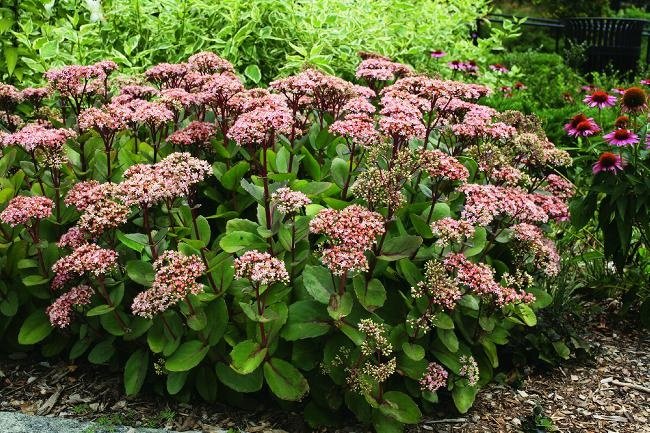
Sedum Matrona belongs to a separate genus of Hylotelephium sedum, it is successfully grown on almost any type of soil
Sedum aizoon
Perennial succulent 25-40 cm high. Forms a bush with straight shoots, densely covered with rhombic leaves with a finely serrated edge. It blooms profusely from June to July, flowers with a diameter of no more than 5 mm, yellow shades, collected in umbrellas inflorescences. Winter-hardy plant, tolerates arid climate and shady places well.
Sedum spectabile
Forms a lush bush with a height of 30 to 50 cm. The shoots are directed upwards, covered with large oblong leaves. Fleshy leaves are painted in a rich green color with a bluish coating. The plant stands out for its long flowering: from August to the first persistent frost. The flowers are very small, scutes collected in dense inflorescences. Color - from all shades of pink to dark purple and lilac colors.
Classification of unpretentious species
Sedums are not considered capricious plants, but there are such types of succulents that are able to delight with active growth and exuberant flowering even in the most severe climatic conditions.
Sedum caustic and its description (Sedum acre Aureum, S. procumbens, S. glaciale, S. neglectum)
A perennial succulent plant that retains greenery even in winter. Plant height does not exceed 15 cm. Stems are spreading, spreading, covered with oval-shaped leaves. The color of the leaves is green - light or dark shades. Sedum pungent blooms from May to September. Inflorescences are yellow, located on shortened peduncles. Sedum flowers are very fragrant, and the plant itself is considered a good honey plant.
Morgan's sedum (Sedum morganianum)
It is a herbaceous perennial plant, it is grown as an ampelous indoor plant. Shoots can reach a length of more than 100 cm. It has pointed fleshy leaves about 2 cm long, tightly pressed to the stem and to each other. It has small flowers, collected in axillary inflorescences. Peduncles are very short, almost invisible.
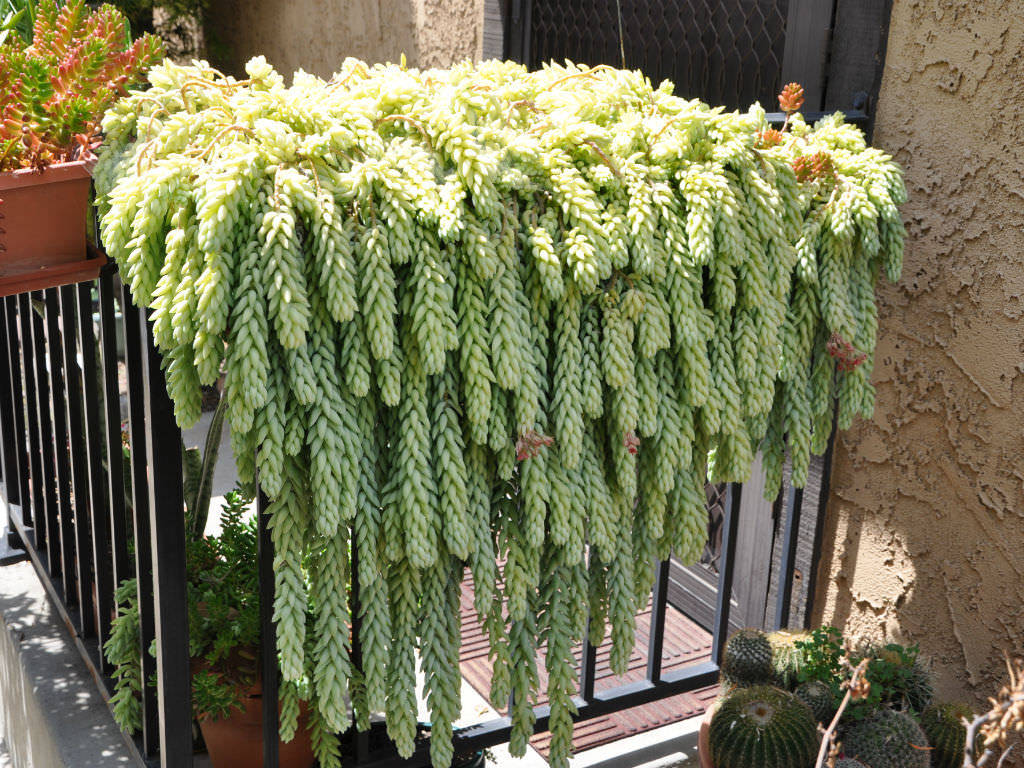
The sedum of Morgan (Sedum morganianum) is popularly called the "donkey's tail" or "the monkey's tail" for its long and massive shoots
Sedum white (Sedum album)
Refers to perennial ground cover evergreen succulents. Forms a dense coating. Creeping stems, covered with small dense green leaves. On sunny glades they acquire a crimson-red hue. Inflorescences are paniculate white. It blooms very fragrant, from June to early August. The plant tolerates frosty winters well, and is also resistant to droughts.
Sedum middendorfianum
A succulent plant forms a bush 25-40 cm high. The leaves are dense, oval in shape with a pronounced jagged edge. The leaf plate is slightly narrowed towards the base. The leaf is green with a white-yellow border. In sunny places, the color of the border is replaced by a bright scarlet color. The flowers are small, yellow-orange in color with well-defined bright anthers. Blooms from June to July. The plant is frost-resistant, prefers sunny places.
The unpretentious species also include Spanish sedum (Sedum hispanicum), six-sided sedum (Sedum sexangulare) and other species.
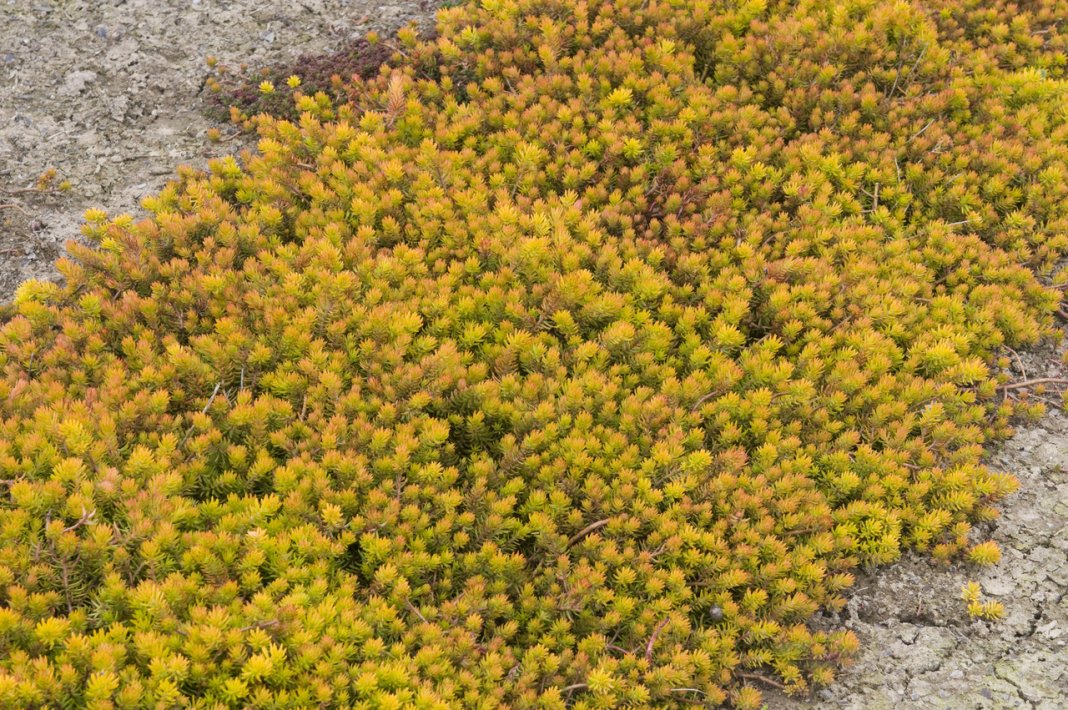
Stonecrop Skalny is widely used in the cooking of some European countries, it is used for the preparation of salads, sauces and soups
Unpretentious sedums:
- pale yellow (Sedum ochroleucum);
- Spanish (Sedum hispanicum, Sedum glaucum);
- rocky, or bent (Sedum Rupestre, Sedum reflexum);
- sedum (Sedum sediforme);
- triple (Sedum ternatum, Sedum americanum);
- narrow-petal (Sedum stenopetalum);
- hex (Sedum sexangulare);
- Evers (Sedum ewersii).
Rare types of stonecrop
There are types of sedum, mesmerizing with their beauty, for which amateur flower growers are ready to pay decent sums.
Sedum gracile
Ground cover plant no more than 5 cm high. Leaves are elongated, jagged along the edge, saturated green. It has flower stalks-umbrellas, directed upwards, up to 10 cm long. Flowers are painted in white or lemon color. Bloom lasts from June to July. Succulent plants are picky about moisture, but tolerate frosty winters very well.
Sedum vine-shaped (Sedum sarmentosum)
Forms bushes 5 to 10 cm high. Shoots are thin, covered with spherical green leaves. Depending on the lighting, their color can vary from light pink to burgundy and purple. Forms small yellow inflorescences. The plant stands out among other stonecrops by its rapid growth rates.
Sedum (Sedum stoloniferum)
Forms a dense covering of flexible shoots covered with fleshy oval leaves. The color of the leaves is blue with a green overflow. Plant height rarely exceeds 10 cm. Stonecrop blooms from June to August. Forms high peduncles up to 30 cm long. Stonecrop flowers are yellow. The plant is very unpretentious, easy to root and tolerates arid climate well.
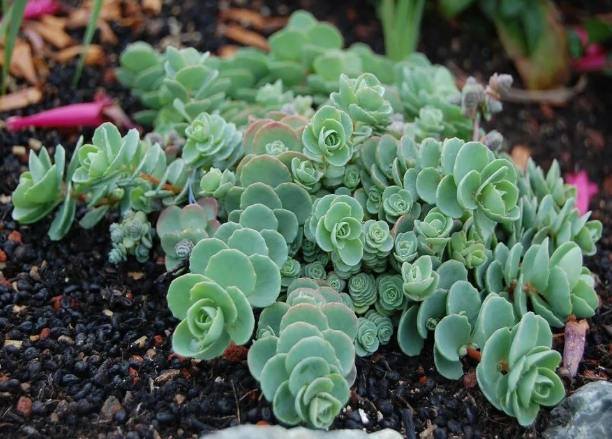
Sedum Evers belongs to unpretentious frost-resistant species
Heat-loving species and their popular varieties
There are sedum species that cannot tolerate cold climates and are intended for indoor cultivation. They are used for landscaping winter gardens, stonecrops look very beautiful in combination with cacti and other types of succulents. Some species are grown as ampelous plants in cascading compositions and hanging pots.
Sedum Lineare
A ground cover plant that forms raised shoots 25-30 cm long. Leaves are elongated, pointed, light green in color with a gray dusting. Some varieties have white edging. It rarely blooms in an apartment, suitable for growing in hanging containers.
Sedum makinoi, Sedum obovatum
A creeping ground cover plant with shoots 15 to 80 cm long. The oval-shaped leaves are bluish in color. The plant is fast-growing, tightly covering the entire surface of the pots. The combination of several varieties of stonecrops Makina with different colors of foliage is very beautiful.
Sedum oregon (Sedum oreganum)
Indoor plant, forming a cover with a height of 10 to 15 cm. Leaves are light green, fleshy, have a spatulate shape. They form small roses at the ends of the shoots. On sunny windowsills, the plant can acquire reddish shades up to burgundy tones.
Popular stonecrops among lovers of indoor floriculture are also:
- polychaete (Sedum polytrichoides);
- sizolytic (Sedum glaucophyllum);
- pretty (Sedum pulchellum).

Potted sedum compositions in combination with other types of succulents will become a unique decoration of a sunny windowsill
How stonecrop multiplies
Florists and landscape designers value sedums not only for their unpretentiousness and versatility, but also for their ease of reproduction. Everyone can get a new plant, the main thing is to decide on the breeding method.
Growing from seeds
Not the most popular way. Quite lengthy and laborious. When growing in this way, you should pay attention to the following nuances:
- Time for boarding. Sowing is carried out in the fall or in the first months of spring.
- The choice of capacity. For seedlings, take small bowls or low trays.
- Soil and seed preparation. It is better to take a ready-made substrate for succulents or prepare a mixture of sand and peat yourself. The tray is filled with soil 1/3. Seeds are sown, covered with foil and stored in a cool place for seed stratification for 10-14 days. The soil is regularly moistened, and after a specified period of time, the open container is taken out to a warm place with a temperature of at least +20 ° C. Already after 2-3 weeks, the emergence of seedlings can be observed.
- Seedling care. The resulting seedlings are watered as the soil dries up, avoiding overflows. Plants are kept in a bright place, protected from direct sunlight.
- Dive and transfer. When the seedlings have two true leaves, they are seated in separate containers.As soon as the plants grow well, they are planted in a permanent place. Stonecrops such as Adolf, intended for indoor home growing, are planted in small pots.
Propagation by stem and leaf cuttings
Sedum is a flower that is easy enough to propagate by cuttings. As a material, you can use not only fragments of the stem, but also leaves of any size.
The leaf or stem is air-dried for several hours, and then planted in small containers filled with moist succulent substrate. The soil around the plant is well compacted. Cuttings are watered occasionally. Already after 2-3 weeks, you can observe how the stalk began to grow.
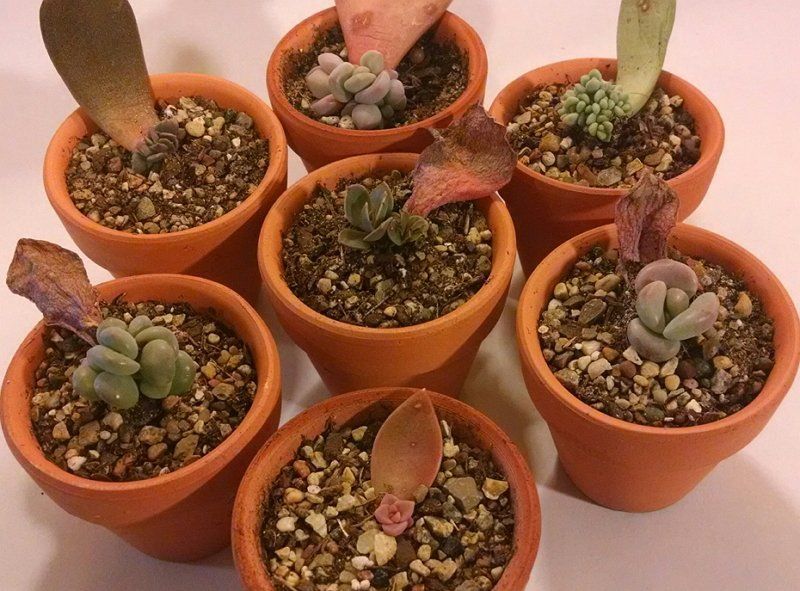
Growing sedum by grafting
Dividing the bush
The simplest and most common method for breeding succulents in the spring. The sedum is dug up, the roots are cleaned from the soil and divided into several parts, which have several young shoots and buds. The plant is air-dried for several hours and planted in a permanent place.
Features of care in the garden
The sedum is classified as an unpretentious plant. But in order for the plant to develop correctly, retain its decorative qualities and please with flowering, you should adhere to the basic requirements:
- Lighting. Most sedum varieties prefer a bright, sunny place, but there are many sedums that grow safely in semi-shady and shady places.
- Temperature conditions. The plant is resistant to summer droughts and frosty winters. However, in damp and little snowy winters, it is better to cover stonecrops with spruce branches or spunbond.
- Watering. Abundant overflows very often lead to the death of the plant.
- Mulching the soil. Peat, pine bark or fine gravel are used as mulching material. This technique helps to retain moisture and minimize the growth of weeds.
- Loosening. Prevents weeds, moisture stagnation, and helps to oxygenate the root system.
- Top dressing. For active growth, ready-made preparations for growing succulents with a high nitrogen content are used.
- Transfer. Sedum should be replanted every 5 years in the spring. For rejuvenation, the plant is divided into several bushes and transferred to a new place. Before planting, sand, fine gravel and complex mineral fertilizers are introduced into the ground. Plants are planted at a distance of 15-20 cm from each other
What is stonecrop afraid of? All types of sedum do not tolerate excess moisture, damp winters and spring flooding.
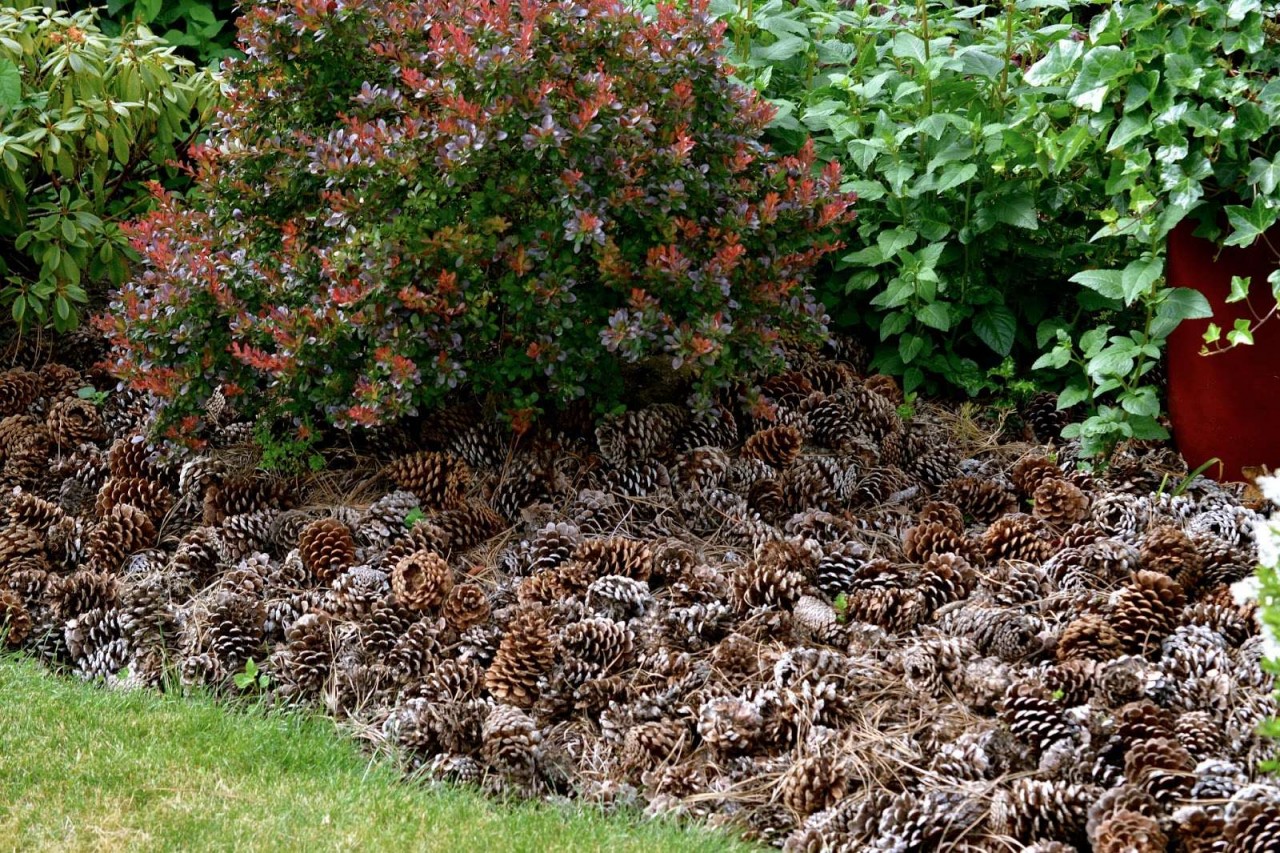
Fine gravel, tree bark, peat, pine and spruce cones are used as a mulching material for stonecrops.
Possible growing problems
Like any other plant, stonecrops can infect pests:
- thrips;
- aphids;
- weevils;
- root nematodes;
- sawflies.
To combat them, insecticides of a wide spectrum of action are used.
Most often, stonecrops overtake fungal diseases. Treatment is carried out using fungicides.
Not only pests and diseases can harm the unpretentious sedum. Often, elementary care errors are the cause of plant death. They are determined by the following criteria:
- shriveled leaves indicate the need for additional watering;
- yellowing of the leaf plates, rotting of the stem are a sign of an excess of moisture;
- elongated stems indicate a lack of lighting;
- leaf discharge can be the result of drying out of the soil or sudden changes in air temperature.
Use in landscape design
Sedum is popular with lovers of beautiful landscapes. Sedums can act as an independent solo group or as part of a composition. They are widely used for decoration:
- rockeries;
- alpine slides;
- multilevel flower beds;
- lawn boundaries;
- allocation of garden paths;
- fountains and artificial reservoirs.
They create suspended structures from numerous pots.

Alpine slide using stonecrops
The variety of sedum varieties is really amazing. They can be found everywhere due to their unique vitality and ease of reproduction. For many gardeners, collecting these interesting plants has become an exciting hobby for more than a decade.
